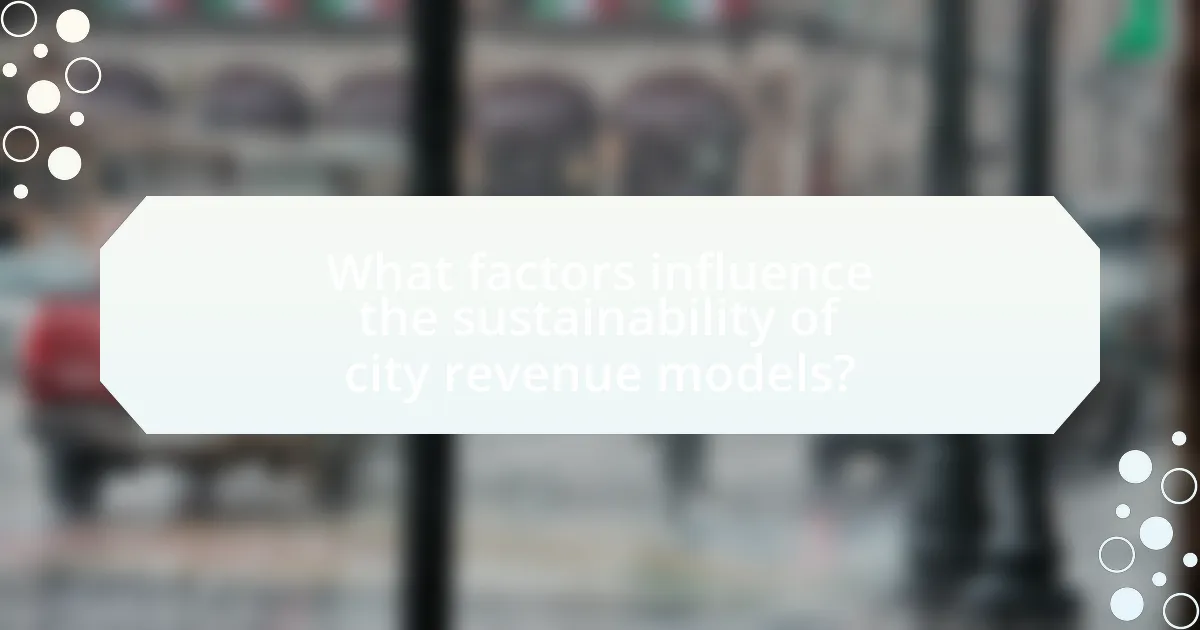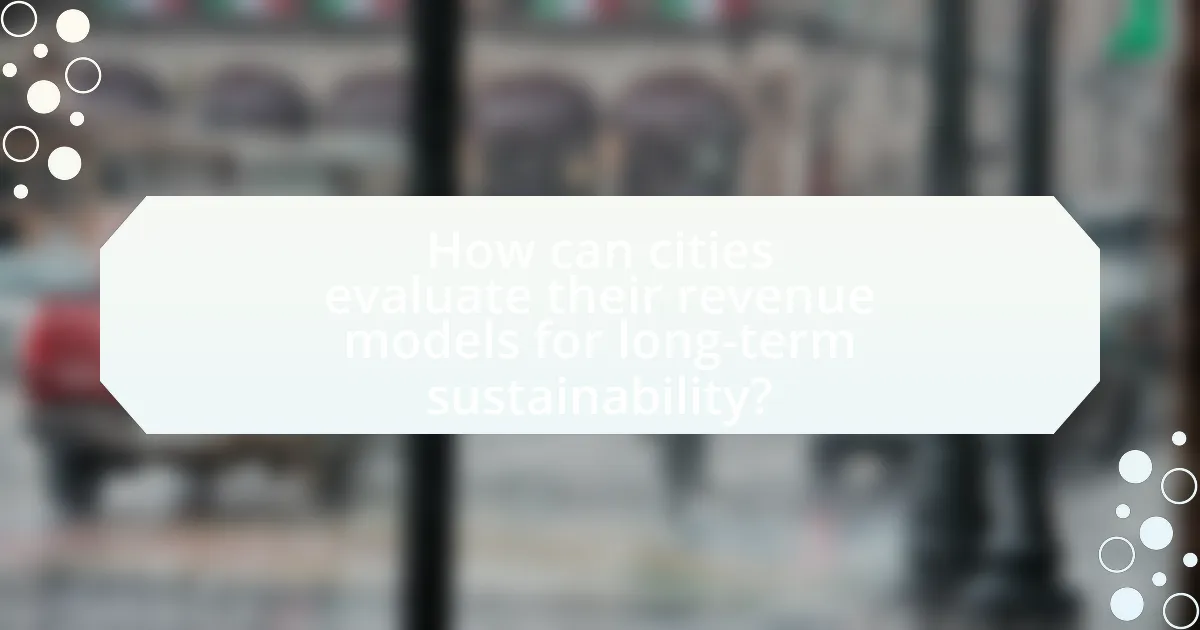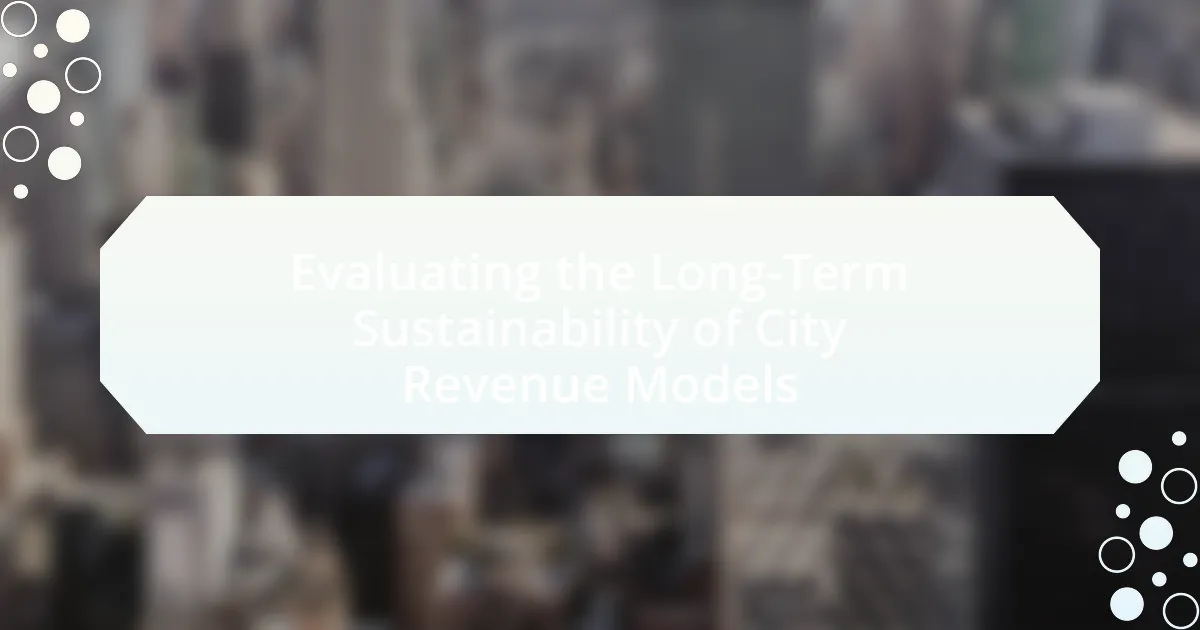The article focuses on evaluating the long-term sustainability of city revenue models, emphasizing the key components such as property taxes, sales taxes, income taxes, fees for services, and intergovernmental transfers. It explores how these revenue sources contribute to city finances, the impact of economic conditions, and the importance of long-term sustainability for funding essential services and infrastructure. Additionally, the article discusses the risks cities face without sustainable revenue models, the influence of demographic changes, and strategies for enhancing revenue sustainability through diversification and community engagement. It also highlights best practices and common pitfalls in revenue planning, providing a comprehensive overview of the factors that affect the financial health of urban areas.

What are the key components of city revenue models?
The key components of city revenue models include property taxes, sales taxes, income taxes, fees for services, and intergovernmental transfers. Property taxes are a primary source of revenue, accounting for approximately 30% of local government revenue in the United States, as reported by the U.S. Census Bureau. Sales taxes contribute significantly as well, often making up around 20% of total revenue. Income taxes, though less common at the city level, provide additional funding in some municipalities. Fees for services, such as water and waste management, generate revenue directly linked to the services provided. Lastly, intergovernmental transfers from state and federal governments supplement local revenues, ensuring cities can fund essential services and infrastructure.
How do different revenue sources contribute to city finances?
Different revenue sources significantly contribute to city finances by providing essential funding for public services and infrastructure. Property taxes, for instance, are a primary source of revenue, accounting for approximately 30% of total city revenues in the United States, which helps finance essential services like education, public safety, and infrastructure maintenance. Sales taxes also play a crucial role, contributing around 20% of city revenues, enabling cities to fund local projects and services. Additionally, fees and charges for services, such as water and sanitation, provide a direct revenue stream that supports operational costs. Grants and intergovernmental transfers from state and federal governments further supplement city finances, allowing for larger projects and initiatives. Collectively, these diverse revenue sources ensure cities can maintain financial stability and invest in long-term sustainability.
What are the primary sources of revenue for cities?
The primary sources of revenue for cities include property taxes, sales taxes, income taxes, and fees for services. Property taxes are typically the largest source, providing essential funding for local services such as education, public safety, and infrastructure. Sales taxes contribute significantly as well, with cities often levying a percentage on retail sales to support various public services. Income taxes, though less common at the city level, can also be a source of revenue, particularly in larger urban areas. Additionally, cities generate revenue through fees for services such as water, sewage, and permits, which help cover the costs of providing these essential services. According to the U.S. Census Bureau, in 2020, property taxes accounted for approximately 31% of local government revenue, highlighting their critical role in city funding.
How do economic conditions affect these revenue sources?
Economic conditions significantly influence city revenue sources by affecting tax revenues, fees, and grants. During periods of economic growth, cities typically experience increased tax revenues from property, sales, and income taxes due to higher consumer spending and property values. For instance, in the United States, the National Bureau of Economic Research reported that during the economic expansion from 2009 to 2019, state and local tax revenues grew by an average of 4.5% annually. Conversely, during economic downturns, such as the 2008 financial crisis, cities faced declining revenues as unemployment rose and property values fell, leading to reduced tax collections. This relationship underscores the vulnerability of city revenue models to fluctuations in economic conditions, impacting their long-term sustainability.
Why is long-term sustainability important for city revenue models?
Long-term sustainability is crucial for city revenue models because it ensures consistent and reliable funding for essential services and infrastructure. Sustainable revenue models enable cities to adapt to economic fluctuations, demographic changes, and environmental challenges, thereby maintaining financial stability. For instance, cities that invest in renewable energy and sustainable practices can reduce operational costs and increase resilience against climate-related disruptions, which ultimately supports ongoing revenue generation. Additionally, research indicates that cities prioritizing sustainability often experience enhanced public trust and engagement, leading to increased compliance with taxes and fees, further solidifying their revenue base.
What risks do cities face without sustainable revenue models?
Cities face significant risks without sustainable revenue models, including budget shortfalls, reduced public services, and increased reliance on debt. Budget shortfalls can lead to cuts in essential services such as public safety, infrastructure maintenance, and education, which directly impact residents’ quality of life. For instance, a study by the National League of Cities in 2021 indicated that 73% of cities reported budget constraints affecting their ability to provide services. Additionally, without sustainable revenue, cities may resort to borrowing, leading to increased debt levels that can strain future budgets and limit financial flexibility. This cycle can ultimately hinder economic growth and exacerbate social inequalities, as cities struggle to meet the needs of their populations effectively.
How can sustainable revenue models enhance city resilience?
Sustainable revenue models enhance city resilience by providing stable funding for essential services and infrastructure, which are critical during crises. These models, such as green taxes, public-private partnerships, and social enterprises, generate consistent revenue while promoting environmental sustainability. For instance, cities that implement green taxes can fund renewable energy projects, reducing dependence on fossil fuels and mitigating climate change impacts. Research indicates that cities with diversified revenue streams are better equipped to respond to economic downturns and natural disasters, as they can maintain service levels and invest in adaptive infrastructure. A study by the Urban Institute found that cities with sustainable revenue practices experienced 20% less budget volatility compared to those relying solely on traditional tax bases. This financial stability directly contributes to a city’s ability to withstand and recover from shocks, thereby enhancing overall resilience.

What factors influence the sustainability of city revenue models?
The sustainability of city revenue models is influenced by economic diversification, demographic trends, technological advancements, and regulatory frameworks. Economic diversification ensures that cities are not overly reliant on a single source of revenue, such as property taxes or sales taxes, which can fluctuate with market conditions. For instance, cities with a mix of industries, including technology, manufacturing, and services, tend to have more stable revenue streams.
Demographic trends, including population growth and migration patterns, also play a crucial role. Cities experiencing population growth often see increased demand for services and infrastructure, leading to higher revenue potential. Conversely, cities facing population decline may struggle to maintain revenue levels.
Technological advancements can enhance revenue collection efficiency and create new revenue opportunities, such as through smart city initiatives that optimize resource use and improve service delivery. For example, cities implementing digital payment systems for parking and utilities have reported increased compliance and revenue.
Lastly, regulatory frameworks, including state and federal policies, can significantly impact a city’s ability to generate revenue. Changes in tax laws or funding formulas can either enhance or restrict a city’s revenue-generating capabilities. For instance, cities that have the authority to levy local taxes or fees often have more sustainable revenue models compared to those that rely solely on state allocations.
How do demographic changes impact city revenue?
Demographic changes significantly impact city revenue by altering the tax base and influencing public service demand. For instance, an increase in population typically leads to higher property tax revenues due to more residential properties, while a shift towards an aging population may increase demand for healthcare and social services, straining budgets. According to the U.S. Census Bureau, cities with growing populations often experience a 10-20% increase in revenue from property taxes over a decade, while cities facing population decline may see revenue drop by similar margins. Additionally, changes in demographics, such as a rise in younger residents, can lead to increased sales tax revenue due to higher consumer spending. Thus, understanding demographic trends is crucial for cities to forecast revenue accurately and plan for sustainable financial models.
What role does population growth play in revenue generation?
Population growth significantly enhances revenue generation by increasing the tax base and demand for goods and services. As the population expands, local governments can collect more taxes from a larger number of residents and businesses, which directly contributes to increased public revenue. For instance, a study by the Urban Institute found that cities with higher population growth rates experienced a corresponding rise in property and sales tax revenues, which are crucial for funding public services and infrastructure. This correlation illustrates that population growth not only boosts economic activity but also provides municipalities with the financial resources necessary to sustain and improve urban environments.
How does aging infrastructure affect revenue sustainability?
Aging infrastructure negatively impacts revenue sustainability by increasing maintenance costs and reducing service efficiency. As infrastructure deteriorates, cities face higher expenses for repairs and replacements, which can divert funds from essential services and investments. For instance, the American Society of Civil Engineers reported that the U.S. needs to invest $4.5 trillion by 2025 to address its aging infrastructure, highlighting the financial burden on municipalities. Additionally, aging systems can lead to service disruptions, which may decrease public trust and reduce revenue from taxes and fees, further straining city budgets.
What economic trends should cities consider for revenue sustainability?
Cities should consider the trends of digital transformation, green economy initiatives, and demographic shifts for revenue sustainability. Digital transformation enables cities to enhance service delivery and efficiency, leading to cost savings and increased revenue through improved tax collection and e-governance. For instance, cities that have adopted smart technologies have reported up to a 30% increase in operational efficiency.
Green economy initiatives, such as investing in renewable energy and sustainable infrastructure, not only attract eco-conscious businesses but also reduce long-term operational costs. Research indicates that cities investing in green technologies can see a return on investment of up to 20% over a decade.
Demographic shifts, including urbanization and changing population dynamics, require cities to adapt their revenue models to meet the needs of a growing and diverse population. For example, cities experiencing significant population growth often see increased demand for housing and services, which can lead to higher property tax revenues.
By focusing on these economic trends, cities can create resilient revenue models that support long-term sustainability.
How do shifts in employment patterns influence city finances?
Shifts in employment patterns significantly influence city finances by altering tax revenue and public service demand. For instance, a transition from traditional manufacturing jobs to technology-based employment can lead to increased income tax revenues due to higher wages in tech sectors. Conversely, if a city experiences job losses in key industries, it may face declining property values and reduced sales tax revenues, as seen in cities that have lost major employers. Additionally, changes in employment can affect the demand for public services; for example, an influx of remote workers may reduce the need for public transportation, while increasing demand for digital infrastructure. These dynamics illustrate how employment trends directly impact a city’s financial health and sustainability.
What impact do technological advancements have on revenue generation?
Technological advancements significantly enhance revenue generation by improving efficiency, reducing costs, and creating new revenue streams. For instance, cities that implement smart technologies, such as IoT sensors for waste management, can optimize resource allocation, leading to lower operational costs and increased savings that can be redirected to other revenue-generating initiatives. Additionally, advancements in digital payment systems facilitate faster transactions and broaden access to services, which can increase overall revenue. According to a report by McKinsey, cities that adopt digital technologies can see a revenue increase of up to 20% through improved service delivery and enhanced citizen engagement.

How can cities evaluate their revenue models for long-term sustainability?
Cities can evaluate their revenue models for long-term sustainability by conducting comprehensive financial assessments that analyze current revenue streams, expenditure patterns, and economic forecasts. This evaluation involves examining the diversity of revenue sources, such as property taxes, sales taxes, and fees, to ensure resilience against economic fluctuations. For instance, cities like San Francisco have implemented performance metrics to assess the effectiveness of their revenue-generating strategies, leading to adjustments that enhance fiscal stability. Additionally, engaging with community stakeholders can provide insights into public needs and preferences, ensuring that revenue models align with sustainable development goals. This approach is supported by studies indicating that diversified revenue streams contribute to greater financial resilience, as evidenced by research from the Urban Institute, which highlights the importance of adaptive revenue strategies in urban governance.
What metrics are essential for assessing revenue model effectiveness?
Essential metrics for assessing revenue model effectiveness include revenue growth rate, customer acquisition cost (CAC), lifetime value (LTV) of customers, profit margins, and churn rate. Revenue growth rate indicates the increase in revenue over time, reflecting the model’s scalability. Customer acquisition cost measures the expense incurred to gain new customers, which should be lower than the lifetime value of those customers to ensure profitability. Lifetime value quantifies the total revenue expected from a customer throughout their relationship with the business, providing insight into long-term sustainability. Profit margins reveal the percentage of revenue that exceeds costs, indicating financial health. Churn rate assesses the percentage of customers lost over a specific period, highlighting retention effectiveness. Collectively, these metrics provide a comprehensive view of a revenue model’s performance and sustainability.
How can cities measure the reliability of their revenue sources?
Cities can measure the reliability of their revenue sources by analyzing historical revenue trends, assessing economic indicators, and evaluating the diversity of revenue streams. Historical revenue trends provide insights into past performance, allowing cities to identify patterns and predict future revenue stability. Economic indicators, such as employment rates and property values, serve as benchmarks for potential revenue fluctuations. Furthermore, a diverse revenue base, including taxes, fees, and grants, reduces dependency on any single source, enhancing overall reliability. Studies show that cities with diversified revenue streams experience less volatility in funding, supporting the assertion that a varied approach to revenue generation contributes to long-term sustainability.
What financial indicators signal potential sustainability issues?
Financial indicators that signal potential sustainability issues include declining revenue growth, increasing debt levels, and rising operational costs. Declining revenue growth can indicate a shrinking tax base or reduced economic activity, which threatens long-term financial stability. Increasing debt levels, particularly if they outpace revenue growth, suggest that a city may struggle to meet its financial obligations, leading to potential insolvency. Rising operational costs, especially those that exceed inflation rates, can strain budgets and limit funding for essential services. These indicators collectively highlight vulnerabilities in a city’s financial health, necessitating proactive measures to ensure sustainability.
What strategies can cities implement to enhance revenue sustainability?
Cities can enhance revenue sustainability by diversifying their revenue streams, which reduces reliance on a single source of income. Implementing strategies such as expanding property tax bases, introducing new business taxes, and enhancing user fees for services can create a more stable financial foundation. For instance, cities like San Francisco have successfully increased revenue by expanding their business tax framework, resulting in a 20% increase in revenue over five years. Additionally, investing in technology to improve efficiency in service delivery can lower operational costs and increase revenue through better resource management. These strategies collectively contribute to a more resilient and sustainable revenue model for cities.
How can diversification of revenue sources improve sustainability?
Diversification of revenue sources can improve sustainability by reducing dependency on a single income stream, thereby enhancing financial stability. When cities incorporate various revenue sources, such as taxes, fees, grants, and investments, they mitigate risks associated with economic downturns or fluctuations in specific sectors. For instance, a study by the Urban Institute found that cities with diversified revenue streams are better equipped to maintain essential services during economic crises, as they can rely on alternative funding sources. This adaptability not only supports ongoing operations but also fosters long-term resilience and sustainability in city revenue models.
What role does community engagement play in revenue model success?
Community engagement is crucial for revenue model success as it fosters trust, enhances participation, and drives local investment. Engaged communities are more likely to support initiatives, leading to increased funding and resource allocation. For instance, cities that actively involve residents in decision-making processes often see higher compliance rates with local taxes and fees, as evidenced by a study from the International City/County Management Association, which found that community involvement can boost revenue by up to 20%. This demonstrates that when citizens feel their voices are heard, they are more inclined to contribute to the financial sustainability of their city.
What best practices should cities follow for sustainable revenue models?
Cities should adopt diversified revenue streams as a best practice for sustainable revenue models. This approach mitigates risks associated with economic fluctuations and enhances financial stability. For instance, cities can combine property taxes, sales taxes, user fees, and grants to create a balanced budget. According to the National League of Cities, cities that diversify their revenue sources are better equipped to handle economic downturns, as reliance on a single source can lead to budget shortfalls. Additionally, implementing technology for efficient tax collection and enhancing public-private partnerships can further optimize revenue generation. These strategies collectively contribute to a resilient financial framework for urban governance.
How can cities learn from successful revenue models in other regions?
Cities can learn from successful revenue models in other regions by analyzing and adapting best practices that have proven effective in generating sustainable income. For instance, cities can study the implementation of innovative tax structures, such as the value capture financing used in cities like San Francisco, which funds public infrastructure through increased property taxes in developing areas. Additionally, cities can examine the use of public-private partnerships, as seen in New York City’s approach to funding public projects, which leverages private investment to enhance public services. By benchmarking against these models, cities can identify key performance indicators and tailor strategies that align with their unique economic and social contexts, ultimately fostering long-term financial sustainability.
What common pitfalls should cities avoid in revenue planning?
Cities should avoid over-reliance on a single revenue source in revenue planning. This pitfall can lead to financial instability, as fluctuations in that source can significantly impact overall revenue. For instance, cities that depend heavily on property taxes may face budget shortfalls during economic downturns when property values decline. Diversifying revenue streams, such as incorporating sales taxes, fees, and grants, can mitigate risks and enhance financial resilience. Historical data shows that cities with varied revenue sources are better equipped to handle economic fluctuations, ensuring long-term sustainability in their revenue models.

Leave a Reply